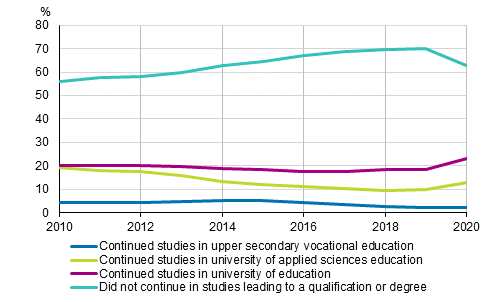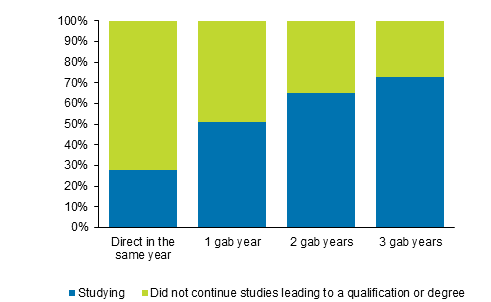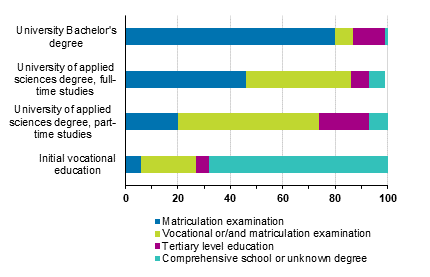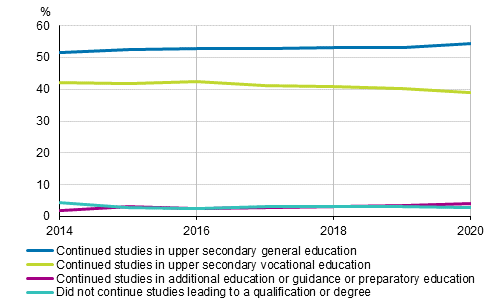Published: 9 December 2021
Entrance to further studies by new passers of the matriculation examination was easier in 2020 than in the year before
According to Statistics Finland's education statistics, entrance to further studies became easier for new passers of the matriculation examination in spring in 2020, when over 37 per cent continued their studies in the same year. Close on 13 per cent continued in university of applied sciences education, 23 per cent in university education and two per cent in vocational education. In all, 2.7 per cent of completers of comprehensive school, around 1,600 pupils, did not continue in education in 2020. Altogether 54 per cent continued in general upper secondary education, 39 per cent in vocational education, one per cent in additional education of basic education (10-grade) and four per cent in guidance or preparatory education.
Direct transition to further studies of passers of the matriculation examination in the spring semester 2010–2020, %

By the decision of the Ministry of Education and Culture, study places were increased in higher education establishments for 2020 to 2022. In 2020, the total number of new passers of the matriculation examination who remained without a further study place went down by seven percentage points from the previous year. The share of those continuing in university of applied sciences education grew by close on three percentage points and that of those in university education by five percentage points. The share of those continuing in vocational education remained unchanged.
The share of men having received a place for further studies immediately in the same year grew by six percentage points and the share of women by eight percentage points. In all, 58 per cent of men and 66 per cent of women did not have a place for further studies. Male passers of the matriculation examination continued more often than women in university and university of applied sciences education, 41 per cent of men and 31 per cent of women started tertiary level studies.
In the year of passing the matriculation examination, 84 per cent of passers of the matriculation examination, 82 per cent of men and 86 per cent of women, applied for a place for further studies. The number of applicants to further studies grew by three percentage points. Application to university of applied sciences education increased and to university education remained unchanged. Fifty per cent of passers of the matriculation examination applied only to university education and 20 per cent applied only to university of applied sciences education. Thirteen per cent of new passers of the matriculation examination applied simultaneously to both university of applied sciences and university education and one per cent to upper secondary vocational education.
No place for further studies for 27 per cent of passers of the matriculation examination after three gap years
Many new passers of the matriculation examination have to have a gap year or years before finding a place for further studies, even though most apply to further studies right after passing the matriculation examination.
Entrance to education by passers of matriculation examination on 2017, %

When examining the placement of new passers of the matriculation examination (30,615) in 2017 to further studies by the end of 2018, slightly over one half had found a place for further studies after one gap year. Forty-five per cent had started studies in tertiary education and five per cent in upper secondary vocational education. After two gap years an ever larger share had started further studies. In 2019, sixty-five per cent studied, 61 per cent in tertiary education and five per cent in upper secondary vocational education. The share of those starting studies after three gap years had grown to 73 per cent.
Very few of those having started studies in universities had vocational qualifications, more so in universities of applied sciences
The majority of those having started lower tertiary degree studies had an upper secondary level qualification as their basic education, 80 per cent the matriculation examination, two per cent an upper secondary vocational qualification and five per cent had both. Slightly over one tenth had previously completed a tertiary degree (also includes post-secondary qualification and vocational tertiary level qualification).
New students by education and prior degree or qualification in 2020, %

Of those who started daytime programmes in university of applied sciences education, 46 per cent were passers of the matriculation examination, 29 per cent had completed a vocational qualification and 11 per cent both the matriculation examination and a vocational qualification. Seven per cent of those having started studies had already completed a tertiary degree. Vocational basic education was more common among those having started education arranged as multiform studies at universities of applied sciences. Nineteen per cent had passed the matriculation examination, 35 per cent had completed a vocational qualification and 19 per cent had completed both. Every fifth had a previously completed tertiary degree as their basic education.
Sixty-five per cent of students in initial vocational education came straight from comprehensive school. Twenty-one per cent had completed a vocational qualification previously. Three per cent had passed both the matriculation examination and completed a vocational qualification and six per cent had passed the matriculation examination. Five per cent of those having started initial vocational education had completed a tertiary level degree.
Nearly 1,600 completers of comprehensive school outside education
There were 58,500 completers of the 9th grade of comprehensive school in 2020. Nearly all completers of the 9th grade of comprehensive school applied immediately to further studies, 0.5 per cent did not do so. In all, 65 per cent of girls and 44 per cent of boys applied primarily to general upper secondary school. Altogether 33 per cent of girls and 53 per cent of boys applied primarily to upper secondary vocational education.
Direct continuation to further studies for completers of comprehensive school 2014–2020, %

Ninety-three per cent of completers of comprehensive school continued in education leading to a qualification. Fifty-four per cent of completers continued in general upper secondary education and 39 per cent in vocational education. The share of those continuing in vocational education decreased from the previous year. A total of 1,500 completers of comprehensive school continued in guidance and preparatory education and almost 800 in additional education of the comprehensive school (10th grade). In all, 1,600 completers of comprehensive school stayed outside all the above-mentioned types of education. When examining the transition, students must have the right to study in effect in September of the same year.
More detailed information on application and transition to further studies of completers of comprehensive school and passers of the matriculation examination, and basic education of applicants to education and new students can be found in the database tables .
Source: Education. Statistics Finland
Inquiries: Anna Loukkola 029 551 3678, koulutustilastot@stat.fi
Head of Department in charge: Hannele Orjala
Publication in pdf-format (231.3 kB)
- Tables
-
Tables in databases
Pick the data you need into tables, view the data as graphs, or download the data for your use.
Appendix tables
Updated 9.12.2021
Official Statistics of Finland (OSF):
Entrance to education [e-publication].
ISSN=1799-4527. 2020. Helsinki: Statistics Finland [referred: 28.12.2025].
Access method: http://stat.fi/til/khak/2020/khak_2020_2021-12-09_tie_001_en.html

